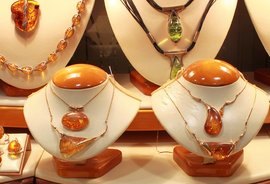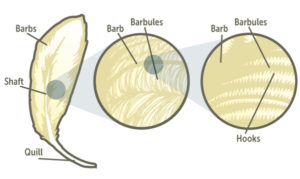Touching a Dinosaur—Almost
Imagine holding a 99 million year old feathered dinosaur tail in the palm of your hand. The only thing keeping you from actually touching its feathers? A few centimeters of petrified resin. This was reality for the group of scientists who published their findings about this discovery in the December issue of Current Biology (1).
It all began roughly ninety-nine million years ago when a young coelurosaur met an untimely death. The size of a sparrow, this theropod (a dinosaur that walks on its hind limbs), was partly covered in tree sap before its body could decompose. This resulted in it being preserved for millions of years in the petrified resin. The dinosaur was most likely a juvenile, not fully grown, but old enough to have adult plumage. Amazingly, a section of this coelurosaur’s tail–complete with feathers–was preserved in that chunk of amber.

Saved from a Silver Lining
The apricot-sized hunk of amber would likely have ended up in a piece of jewelry if scientists visiting an amber market in Myitkyina, the capital of Kachin State in Myanmar, hadn’t recognized those feathers for what they were. Now, instead of resting as the focal point of a necklace, this specimen is helping scientists understand the evolution of dinosaur feathers.
The Tail That Has Paleontologists Wagging
Putative dinosaur feathers have been found preserved in amber before, so why are scientist so excited about this particular piece of amber? It is because this specimen contains almost one and a half inches of a coelurosaur tail, complete with eight vertebrate and the carbonized remains of tissue. This means that, for the first time, scientist are able to associate preserved feathers with the skeletal remains of a dinosaur, which gives them insight into the evolutionary pattern of feathers. Scientists believe that the feathers covered the entire length of this dinosaur’s tail.

The feathers in this sample are incredibly well preserved. This allowed the scientist to study the structure of the feathers in great detail. Feather structure (see figure) is useful for scientist to determine evolutionary path dinosaurs took from flightless to flight. For example, the barbules in this sample are so clearly preserved that the configuration could be observed in detail. The barbule distribution show barbules that branch from the within barbs as well as from the shaft (rachis) itself. This configuration is different than that seen in later samples and in feathers today. The findings suggests that barbules were once distributed evenly along the feather, and at a later evolutionary point they became restricted to the barbs and center shaft.
Piecing Together the Path to Powered Flight
Feather structure and flight modes are proving to be surprisingly diverse in small theropods dating to near the origin of birds and powered flight. This incredible find adds another morphotype to the diversity. Because these feathers were preserved attached to a section of the supporting structure (tissues and vertebrae), the scientist were also able to determine feather counts and orientation of the plumage along the tail. The paired feather arrangement present in this sample is similar to that found in modern birds. This suggests that this pattern was established in basal tail plumage before the pygostyle (the rigid structure in modern birds caused by the fusing of the fused caudal vertebrae) developed. New discoveries like this help scientists build a more complete model of the morphological changes that will help inform the evolutionary path to flight. However, the value of this sample is not just the feathers, it also offers exquisitely preserved details of feathered dinosaurs’ skeletal and tissue structure.
Amazing Amber
Although there is no disputing the scientific value of this discovery, there is also a coolness factor to the discovery that transcends scientific discovery. Imagine what else could be out there, preserved and protected in a cocoon of amber. There are endless tantalizing possibilities of what else we might find. Personally, I will never look at an amber necklace in the same way.
Reference
- Xing, L. et al. (2016) A feathered dinosaur tail with primitive plumage trapped in mid-cretaceous amber. Current Biology December 19. In press. http://dx.doi.org/10.1016/j.cub.2016.10.008
Kelly Grooms
Latest posts by Kelly Grooms (see all)
- The Battle of Shiloh’s Angel’s Glow: Fact, Civil War Legend or Modern Myth? - July 11, 2024
- Mind Control, Mutilation and Death. The Fungal Fate That Lurks in Waiting for Emerging Periodical Cicadas - June 13, 2024
- Measles and Immunosuppression—When Getting Well Means You Can Still Get Sick - May 13, 2024
